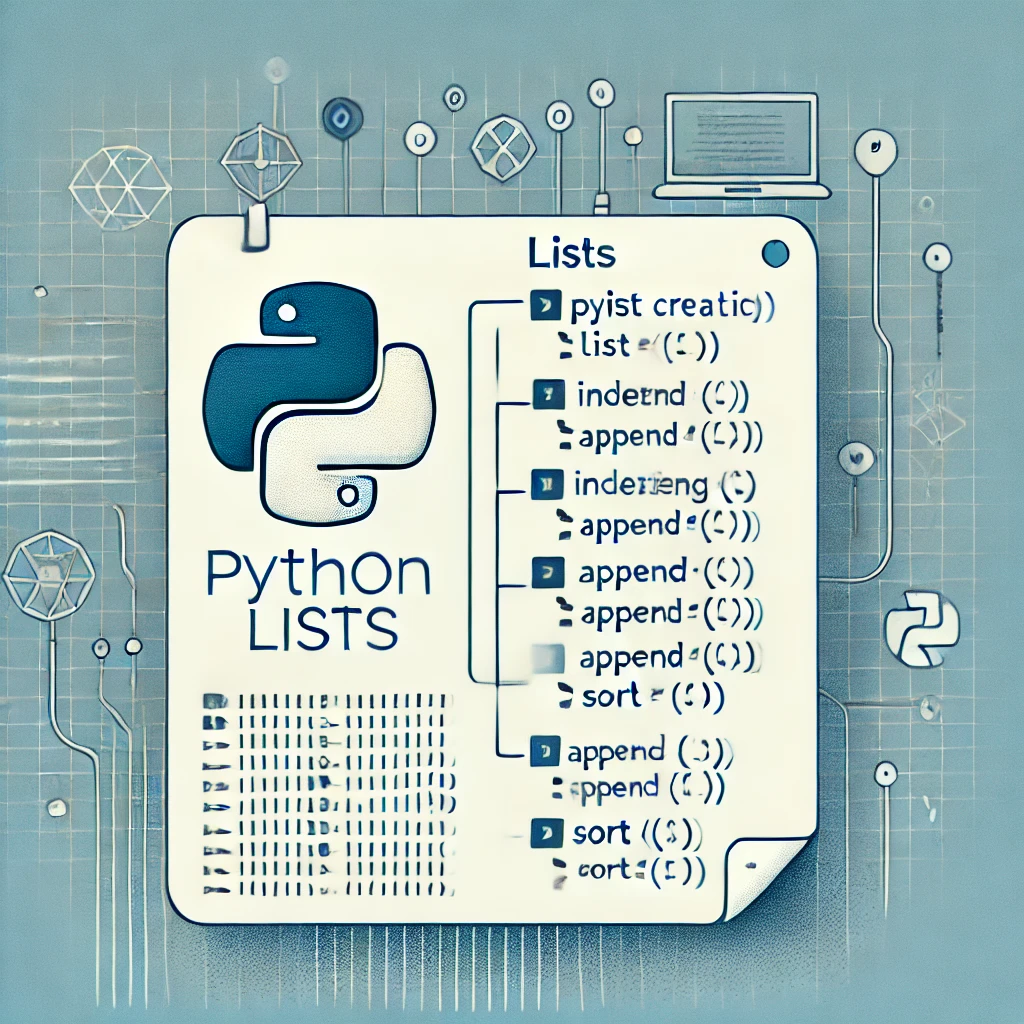In Python programming, lists are one of the most versatile and widely used data structures. Their ability to store multiple elements, ranging from integers and strings to more complex types, makes them a fundamental part of Python coding. In this article, we will explore the concept of lists in Python, their functionality, and the many ways to manipulate them efficiently.
What is a List in Python?
A list in Python is an ordered collection of items. These items can be of different data types such as integers, floats, strings, or even other lists (nested lists). Unlike some other programming languages where arrays have fixed lengths and only store one type of data, Python lists are dynamic and can contain mixed data types. They are mutable, meaning that the elements in a list can be changed after the list is created.
Lists in Python are defined by enclosing elements within square brackets [], separated by commas.
Example:
# Defining a list of mixed data types
my_list = [1, 'apple', 3.14, True]In this example, my_list contains an integer, a string, a float, and a Boolean.
Key Features of Python Lists
- Ordered: The elements in a list have a defined order, and each element can be accessed using its index.
- Mutable: You can change elements within a list after it’s been created.
- Dynamic: Lists in Python can grow or shrink in size, allowing flexibility in storing data.
- Heterogeneous: A list can contain elements of different data types.
Basic List Operations
Python provides numerous operations for working with lists. Below are the most commonly used ones:
1. Creating Lists
Lists can be created using square brackets [], or the list() constructor.
# Empty list
empty_list = []
# List with elements
fruits = ['apple', 'banana', 'cherry']
# Using the list() constructor
numbers = list((1, 2, 3, 4, 5))2. Accessing List Elements
You can access elements from a list using the index of the element. Indexing starts from 0 for the first element.
# Accessing the first element
print(fruits[0]) # Output: 'apple'
# Accessing the last element
print(fruits[-1]) # Output: 'cherry'3. Modifying Lists
Since lists are mutable, you can modify elements by directly assigning a new value to an index.
# Changing the second element
fruits[1] = 'blueberry'
print(fruits) # Output: ['apple', 'blueberry', 'cherry']4. Adding Elements to a List
There are several methods to add elements to a list:
- append(): Adds an element to the end of the list.
- insert(): Inserts an element at a specified position.
- extend(): Adds elements from another list (or any iterable) to the end of the list.
# Append an element
fruits.append('orange')
print(fruits) # Output: ['apple', 'blueberry', 'cherry', 'orange']
# Insert an element at index 1
fruits.insert(1, 'kiwi')
print(fruits) # Output: ['apple', 'kiwi', 'blueberry', 'cherry', 'orange']
# Extend the list with another list
more_fruits = ['grape', 'pineapple']
fruits.extend(more_fruits)
print(fruits) # Output: ['apple', 'kiwi', 'blueberry', 'cherry', 'orange', 'grape', 'pineapple']5. Removing Elements from a List
You can remove elements using the following methods:
- remove(): Removes the first occurrence of a specified value.
- pop(): Removes and returns the element at a given index (or the last element if no index is provided).
- clear(): Removes all elements from the list.
# Remove 'kiwi' from the list
fruits.remove('kiwi')
print(fruits) # Output: ['apple', 'blueberry', 'cherry', 'orange', 'grape', 'pineapple']
# Pop the last element
last_fruit = fruits.pop()
print(last_fruit) # Output: 'pineapple'
print(fruits) # Output: ['apple', 'blueberry', 'cherry', 'orange', 'grape']
# Clear the list
fruits.clear()
print(fruits) # Output: []6. Slicing Lists
Slicing allows you to extract a portion of a list by specifying a start and end index. Python uses the syntax list[start:stop].
numbers = [10, 20, 30, 40, 50, 60, 70, 80]
# Extract elements from index 2 to 5
slice_numbers = numbers[2:6]
print(slice_numbers) # Output: [30, 40, 50, 60]
# Extract elements with a step
step_numbers = numbers[1:7:2]
print(step_numbers) # Output: [20, 40, 60]Advanced List Operations
1. List Comprehension
List comprehension provides a concise way to create lists. It consists of brackets containing an expression followed by a for clause.
# Creating a list of squares using list comprehension
squares = [x**2 for x in range(1, 6)]
print(squares) # Output: [1, 4, 9, 16, 25]2. Nested Lists
Python lists can hold other lists, allowing the creation of matrices or more complex data structures.
# A 2x3 matrix as a nested list
matrix = [[1, 2, 3], [4, 5, 6]]
print(matrix[0][1]) # Output: 23. List Functions and Methods
Python provides several built-in functions and methods for working with lists:
- len(): Returns the number of elements in a list.
- max() / min(): Returns the largest or smallest element in the list.
- sum(): Returns the sum of all elements in the list (if they are numeric).
- sorted(): Returns a sorted version of the list.
numbers = [10, 5, 8, 3]
# Length of the list
print(len(numbers)) # Output: 4
# Maximum value in the list
print(max(numbers)) # Output: 10
# Sum of all elements
print(sum(numbers)) # Output: 26
# Sorted list
print(sorted(numbers)) # Output: [3, 5, 8, 10]Handling Lists with Different Data Types
Python lists can hold mixed data types. However, you should be mindful of operations that require elements to be of the same type. For example, adding integers and strings will result in an error.
mixed_list = [1, 'apple', 3.14]
# Attempt to sum elements (this will cause a TypeError)
# total = sum(mixed_list) # Uncommenting this will cause an errorCommon Mistakes and Best Practices
1. Modifying Lists While Iterating
Altering a list while iterating over it can cause unexpected behavior. Instead, iterate over a copy or use list comprehension.
# Incorrect way
for fruit in fruits:
if fruit == 'apple':
fruits.remove(fruit) # Can cause issues
# Correct way
fruits = [fruit for fruit in fruits if fruit != 'apple']2. Using List Comprehensions Wisely
List comprehensions are powerful but can lead to less readable code if overused. Use them when they improve code clarity.
Conclusion
Lists are an essential and powerful tool in Python programming. Their flexibility allows for efficient data manipulation, whether you’re working with simple data or more complex structures like nested lists. Understanding how to use lists effectively will greatly enhance your ability to write clean and efficient Python code.
Key Takeaways:
- Lists are ordered, mutable, and can hold mixed data types.
- They support a variety of operations, from indexing and slicing to appending and removing elements.
- Python provides numerous built-in functions for working with lists, making them highly versatile.
By mastering lists in Python, you will improve your coding skills and become more adept at handling data in a flexible and efficient manner.


Leave a Reply